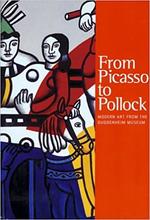More about Solomon R. Guggenheim Museum
- All
- Info
- Shop
Works at Solomon R. Guggenheim Museum

Contributor
As it usually does, the Guggenheim all started with a good ol’ fashion love triangle.
The very married Solomon R. Guggenheim was in love with the curator and German baroness Hildegard Anna Augusta Elizabeth Freiin Rebay von Ehrenwiesen (aka Hilla von Rebay). Their relationship, though never outwardly explained as intimate, was 100% intimate. One of the Guggenheim grandchildren put it best, “She was one of my grandfather's confidants -- and that's a wide field." She called him “Guggi” (barf) and he claimed financial responsibility for her love of art. Her taste was pretty impeccable though and so the Solomon R. Guggenheim Museum was born. Too bad, the Guggenheim family hated Hilla (she could be a bit betchy and was def sleeping with their dad/husband/uncle). Despite her thorough involvement with the building of the current museum, after the death of Solomon, the GuggenheimsTM made sure she never stepped foot in the building and expelled her from the board of directors.
The zygote of the Solomon R. Guggenheim Museum was Solomon’s exhibit in his Plaza Hotel room. In 1937, the Solomon R. Guggenheim Foundation was founded and they began to rent a space in midtown Manhattan to display the work, where Robert De Niro’s father was a security guard. But soon there wouldn’t be enough space for their now giant collection. So Solomon and Hilla sat down and wrote a letter to the famous architect, Frank Lloyd Wright asking him to design a building for their modern art museum, which he accepted. 15 years and 700 sketches later, they had a plan. And in 1959, 10 years after the death of Solomon and only six months after the death of Frank Lloyd Wright, the museum opened its doors for the first time.
The museum’s design was definitely the most outlandish the world had ever seen. They called it an inverted cupcake, a giant Jell-O mold, a washing machine, “New York’s Strangest Building,” a “temple of the spirit” and an “inverted ziggurat.” In 2008, the building was named a National Historic Landmark (rightfully so). This of course caused the manufacturing of ridiculous Guggenheim-related merchandize. For example, in the case that you want to brainwash your children into being an architect, you can buy a Guggenheim Lego set. Or if you want to wear rubble around your neck, you can wear “Restoration Rocks,” jewelry made from the leftover pieces of the renovation of the museum. You would think that the Guggenheims, one of the old money families of America, could do better than debris jewels, but who are we to judge?
Sources
- Knöfel, Ulrike. "Guggenheim's Muse: The German Artist Who Inspired The Museum Gets Her Due In New Show - SPIEGEL ONLINE - International". SPIEGEL ONLINE. N.p., 2005. Web. 27 Mar. 2017.
- "50 Guggenheim Facts". Facebook.com. N.p., 2010. Web. 27 Mar. 2017.
- "Solomon R. Guggenheim Museum". En.wikipedia.org. Web. 27 Mar. 2017.
Featured Content
Here is what Wikipedia says about Solomon R. Guggenheim Museum
The Solomon R. Guggenheim Museum, often referred to as The Guggenheim, is an art museum at 1071 Fifth Avenue between 88th and 89th Streets on the Upper East Side of Manhattan in New York City. It hosts a permanent collection of Impressionist, Post-Impressionist, early Modern and contemporary art and also features special exhibitions throughout the year. It was established by the Solomon R. Guggenheim Foundation in 1939 as the Museum of Non-Objective Painting, under the guidance of its first director, Hilla von Rebay. The museum adopted its current name in 1952, three years after the death of its founder Solomon R. Guggenheim. It continues to be operated and owned by the Solomon R. Guggenheim Foundation.
The museum's building, a landmark work of 20th-century architecture designed by Frank Lloyd Wright, drew controversy for the unusual shape of its display spaces and took 15 years to design and build; it was completed in 1959. It consists of a six-story, bowl-shaped main gallery to the south, a four-story "monitor" to the north, and a ten-story annex to the northeast. A six-story helical ramp extends along the main gallery's perimeter, under a central ceiling skylight. The Thannhauser Collection is housed within the top three stories of the monitor, and there are additional galleries in the annex and a learning center in the basement. The museum building's design was controversial when it was completed but was widely praised afterward. The building underwent extensive renovations from 1990 to 1992, when the annex was built, and it was renovated again from 2005 to 2008.
The museum's collection has grown over the decades and is founded upon several important private collections, including those of Guggenheim, Karl Nierendorf, Katherine Sophie Dreier, Justin Thannhauser, Rebay, Giuseppe Panza, Robert Mapplethorpe and the Bohen Foundation. The collection, which includes around 8,000 works as of 2022, is shared with sister museums in Bilbao, Spain and Venice, Italy. In 2023, nearly 861,000 people visited the museum.
Check out the full Wikipedia article about Solomon R. Guggenheim Museum






















